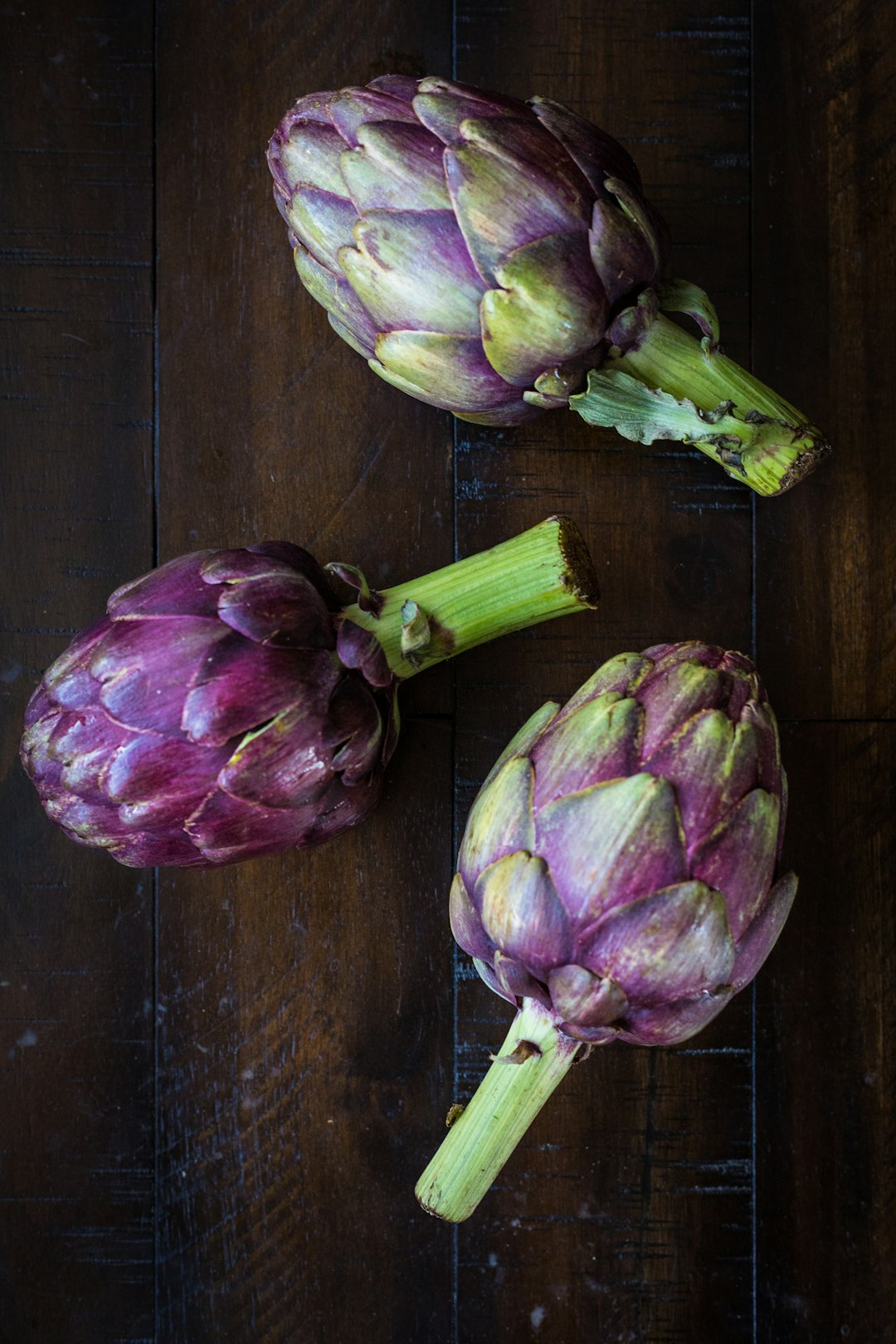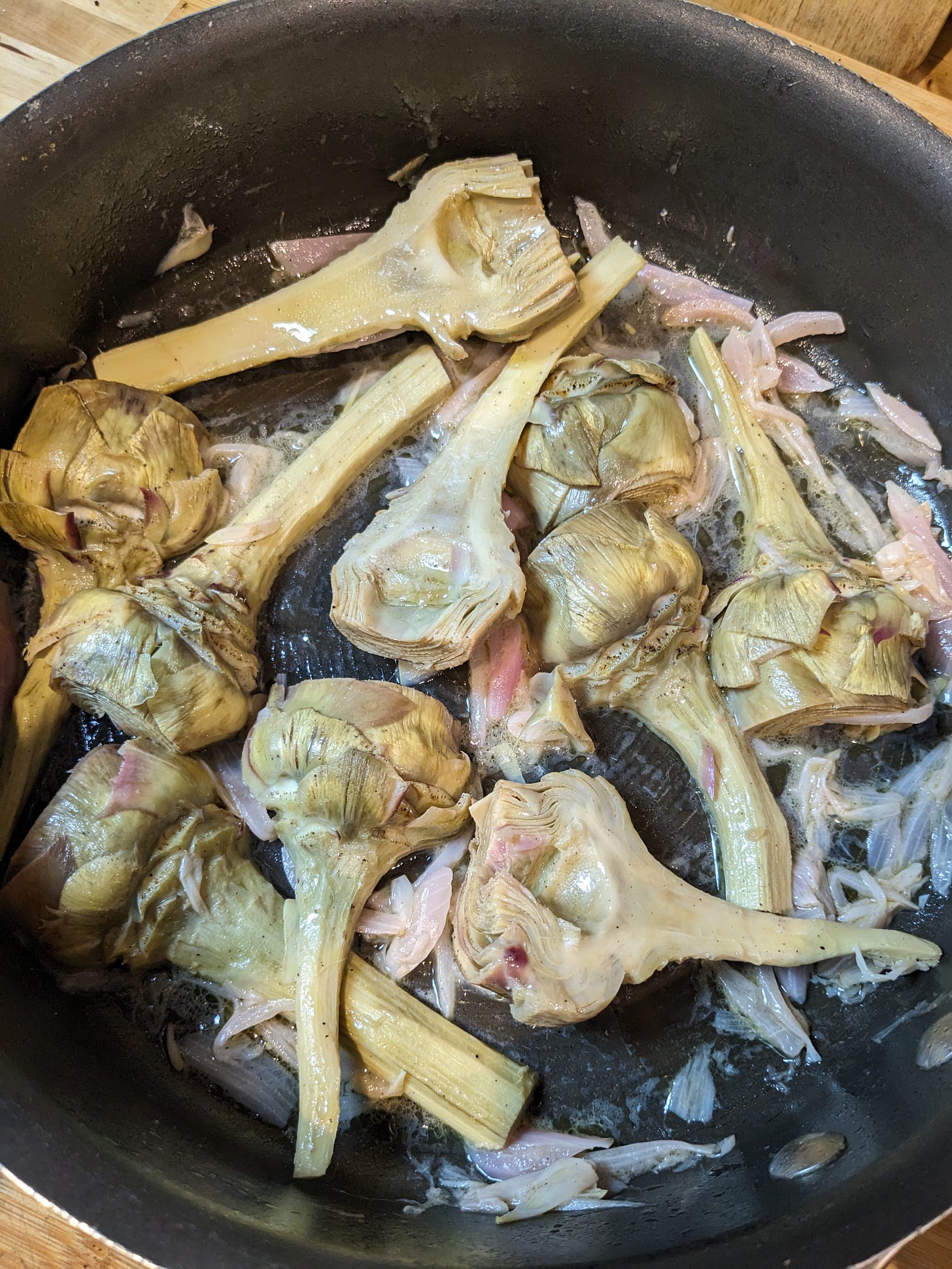What Man has elected to eat over the centuries - sustenance such as snails, shrimp, oysters, eel and other odd stuff that has become Instagram-able mainstream to those lucky enough to patronise restaurants - makes you wonder why we create such a stooshie (not that London girl band but the excellent Scottish word for a rumpus) over tucking into insects.

At this time of year, small purple artichokes sold by the bunch are coming into the stores. Whatever possessed our ancestors to decide a prickly thistle with an interior toothbrush that sticks in the throat if you don’t remove it might be worth eating? The larger more familiar globe artichokes make some sort of sense in that they do provide a thumb nail’s half-moon of meat to scrape off the base of each leaf by dragging it over your bottom teeth - that’s if you haven’t been warned by your pricey dentist that such an action might incur a massive future invoice. But spring’s miniature artichokes like those in the photo? Why would we bother?
When I was insouciant/air-headed enough to do such a thing as to run away to live in a tiny Greek fishing village, I learned the harvesting of baby artichokes symbolised the arrival of spring. Once the elder women of the community had overcome their understandable suspicion of me, they took me under their wing. Clearly I was a crazy person from somewhere far over northerly regions who knew nothing about anything and if she weren’t taken in hand would probably bring untold disaster upon herself and the village through ignorant and squalid practices in her kitchen. So they had better teach me how to feed myself.
Artichokes were the first of the year’s challenges.
Artichokes are domesticated versions of wild cardoons. Cardoons are now beyond uber-hip, and the star of many a young chef flexing his in-touch-with-Mother-Nature’s-less-known-bounty muscles. As with the “Who came first, the Greeks or the Romans?” argument, the origins of the artichoke debate is: was it first a food of the ancient Greeks or the ancient Romans? The cardoon is mentioned as a garden plant, therefore deliberately cultivated from the wild, in 8th century BC by Homer. Score 1 to the Greeks. Hold on, though: Pliny the Elder mentions the growing of carduus (cardoons) in Carthage and also in Cordoba in Spain. That makes 1 for the Ancient Italians. But the Egyptians also have a stake in the First in Thistle Consumption competition: Seeds of cultivated artichokes were found in the Egyptian excavations of Mons Claudianus, an excavation in the eastern desert of the Roman period. So maybe the Romans could claim that one, too.
Over one hundred-forty varieties of artichoke, Cyrnara scolymus, exist, but less than forty are commercially grown. (I thought there were only two.) They are all members not of the thistle family but of the daisy-ish Aster family.

The small early spring versions of the large globe artichoke are no more than their young offspring. They are harvested from the lower stems of the artichoke plant close to the ground before they are allowed to mature into those artichokes we boil to eat with melted butter or vinaigrette. They are such an unnecessary vegetable they represented to the rich and powerful of yore the epitome of civilised dining and were considered the aristocrat of the Renaissance kitchen garden. It is said Catherine de Medici ate so many of them at a wedding feast in 1575 it was feared she would burst open. Henrietta Maria, wife of King Charles I, kept a garden at her manor house in Wimbledon, West London, devoted exclusively to them. These, of course, were the adult artichokes, not the smaller ones I was introduced to in Greece.
There, I was taught to make them into a one-dish meal. Their lower leaves were pulled backwards on themselves until they snapped, the yiayias - Greek grannies - turning the bulb round and round until a substantial belt of a lemon yellow colour was revealed. “Oh, no!” exclaimed a woman at London’s Borough Market where I was buying them this week who had asked how I would be cooking them. “What a waste!” No. You’re only eliminating the tough top of the leaves. What’s left is what you would be dragging back against your bottom teeth if they were boiled globe artichokes.
The yiayias took me in hand. They taught me to fill a mixing bowl with water and squeeze into it the juice and carcass of a fat lemon to keep the artichokes from turning brown. Each artichoke was sliced lengthways in two, and its immature choke scooped out with the tip of a teaspoon then the artichoke flung into the bowl before the next one was tackled. Once they were all prepared, a large deep pan was set onto a medium flame, a very generous glug of olive oil was sloshed into it and heated up gently, the artichokes were drained and added to the pan along with the juice of two lemons, the slivers of at least two large cloves of garlic, then water to come up to the level of the artichokes. Sometimes a bunch of fresh dill was chopped into it, broad beans were added, along with the season’s new potatoes, quartered.
My problem with Substack is I keep forgetting to take photographs before I realise I’ve eaten the dish. So this is a half-way house picture of ‘Violettes’ artichokes, as they’re known in France, being cooked to serve at room temperature as a lemony salad and without the broad beans and potatoes. Sorry about that. But to make a meal of them, here’s the recipe.
12 Violettes or other spring baby artichokes
2 lemons
225g/½ lb small potatoes, scrubbed
700g/1½lb broad beans, shelled. Frozen are what I use
1 large bunch scallions/spring onions
2-3 tablespoons chopped fresh dill (optional)
1 teaspoon chopped fresh mint leaves
1 wine glass (isn’t that more fun than ¾ cup?) olive oil
Salt and freshly ground black pepper to taste
Fill a large mixing bowl with water and squeeze in the juice of a lemon and throw in the carcasses. Snap back the lower leaves of the artichokes until half way up. Slice the artichokes across at that point and discard the pointy leaf tops. With a potato peeler, peel the stalks of the artichokes, trimming off their base. Slice the artichokes in half, longways. With a sharp tipped teaspoon, scrape out the young choke and discard.
Cut the potatoes into large cubes. Put them with the scallions, dill and mint into a large pan with the olive oil and saute them over low heat for 10 minutes. Arrange the artichoke halves over them, cut side down. Add the juice of the second lemon and water just to cover.
Take a large sheet of greaseproof/parchment paper and run it under the tap to soak it. Shake out the water, crumple it and lay it over the artichokes. Cover the pan with a lid and stew the artichokes for 30-40 minutes until a knife goes cleanly through the fattest part and the water has evaporated. (If it hasn’t, remove the paper and the lid and turn the heat up a little and cook until all that’s left is the olive oil, shaking the pan regularly. Serve at room temperature.




Insignificant as it may be, if artichokes were cultivated in Carthage it would be Phoenicia, not Roman, and Córdoba was Roman but likely later than the Greeks or Phoenicians. None of this detracts in the least from the appeal of artichokes, violette or otherwise!
I've only ever eaten baby artichokes once, in a restaurant in Aubagne, as part of their 'Salade Gourmande' - the sort of salad you need a four-course appetite to finish! Your recipe sounds yummy (as always), so definitely on my 'To Try' list. Once my artichoke produces enough little buds to harvest ...